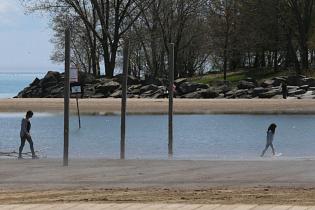Water levels rise on Toronto’s eastern beaches
Anthony Spence arrived at Woodbine Beach, Frisbee in hand, on a lovely long weekend Sunday, the weather finally hinting that this really could be the unofficial kickoff to summer.
The first thing he did was utter an expletive.
So much of the sand was submerged — a surprise to Spence — that there seemed to be no unoccupied space large enough for him and his friends to play a planned pickup game of beach ultimate Frisbee.
Though not as large as it was in 2017, a massive pond has again formed and is lingering on a swath of the east-end beach, swamping some of the volleyball courts and covering an area that would typically be flooded with frolicking families.
“It’s part of nature and things happen, but it’s also just like, what are we going to do now?” said Spence, who had travelled more than an hour from Thornhill on transit for a game that likely wasn’t going to happen.
In 2017, record high water levels in Lake Ontario flooded Woodbine Beach and had water lapping up against the boardwalk and drowning some walkways in Ashbridge’s Bay Park.
Hit harder were the Toronto Islands. Dozens of homes were damaged and the popular tourist spot was closed for three months.
Water levels are edging up again. At the end of last week, Lake Ontario was at 75.74 metres, up from 75.42 on May 1. The long-term average, measured from 1918 to 2018, is 75.02 metres.
“The lake levels are almost at what they were in 2017. They’re edging towards that,” said city spokesperson Brad Ross.
The highest daily level recording during the 2017 flooding was 75.93 metres.
The Toronto and Region Conservation Authority (TRCA) issued a shoreline hazard warning last Thursday and cautioned that properties that were hit by flooding and erosion in 2017 “could continue to experience impacts as the water level in Lake Ontario continues to rise.”
The TRCA said shortened beaches, erosion, trail and boardwalk closures, localized ponding and flooding have already been spotted at various points along the Toronto waterfront. Beyond the eastern beaches and the Islands, sites affected by those issues include Sunnyside Beach, Marilyn Bell Park and the Scarborough Bluffs.
Ross said since 2017 Toronto has taken measures to mitigate the damage that hit the Islands, particularly the homes on Ward’s Island, even if water levels again hit record levels.
“We’ve got something like 20 industrial-sized pumps that have been working 24-7 to pump that water, any water that breaches, back into the lake,” he said.
Ross noted there are thousands of sandbags along the shoreline as well as a 60-metre tube filled with water that also acts as a barrier. The ferry docks were also rebuilt so that the boats can continue to operate despite rising water levels.
“The Island will remain open,” he said.
The residents of Ward’s Island held a “sandbagging party” on Saturday, coming together as a community to further protect their homes and shoreline.
As for the pond on Woodbine Beach, Ross said it should be “more or less” gone some time in June.
“The TRCA think that in about two weeks, the lake water levels will start to go down, back to their normal levels,” said Ross. “The water that’s there now on the beach will recede and any ponding that’s left, we’ll pump that out. But we kind of have to let nature run its course.”
In the meantime, the city’s Victoria Day fireworks, originating from Ashbridge’s Bay Park, will take place Monday night at dusk. Some of what would be a prime viewing location is covered by water.
Ross, though, encouraged people to attend.
“(Most of) the volleyball courts are dry. The boardwalk is dry. The parkland around the boardwalk is dry. While there won’t be as much room for people as there normally would be, there’s still going to be lots of room,” he said.
Apart from rainfall, one of the factors contributing to Toronto’s shoreline concerns, Ross explains, is the record high water level in Lake Erie. That water flows over Niagara Falls into Lake Ontario and then to the St. Lawrence River. But because of severe flooding downriver, regulators have been forced to slow the outflow through the Moses Saunders Dam in the St. Lawrence near Cornwall.
“They have to be very careful about how much water they let out of the lake,” he said.
So that, in turn, resulted in a scene like Sunday at Woodbine Beach and Ashbridge’s Bay Park, where hundreds of visitors still enjoyed the beach, just less of it.
About 30 to 40 of the 100-plus volleyball courts appeared to be unplayable — seagulls waded through water on the southernmost courts – but there was still a tournament taking place.
It was the first of the season for the Ontario Volleyball Association, and beach tour director Oklend Llakaj said they were fine because they needed only 29 courts. Some upcoming events are bigger, however, and he said in 2017 some age groups had their tournaments cancelled or moved to other venues. He said that season they were down more than 60 courts at times.
“I don’t want to go through that again. Losing that many courts has a big impact on the tour and the experience of the kids and their parents,” he said.
Comments
There are 0 comments on this post





